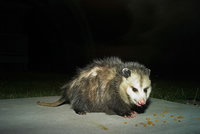Opossum

Peak Nuisance Period: Anytime of Year
Common Nuisance Situations:
- Raid gardens, chicken coops, bird feeders, pet food, and garbage.
- Sometimes den in garages or attics and make a mess.
- They are an opportunist and will utilize old Groundhog holes.
- A parasite found in the feces of opossums can contaminate water and food sources for horses (both hay and feed). This parasite can transmit a disease to horses, called “equine protozoal myelitis.” This disease affects the nervous system and can cause lameness.
- Disease risks to people: mange, rabies (rarely).
Animal Characteristics
Description:
- They have grizzled gray hair, with a mix of black underfur and longer white guard hairs.
- Their head is pointed with a long nose long. Their face is white, with long whiskers, ears are small, round and black with a white tip. Legs are short and black, feet have 5 digits; hind feet have opposable, grasping inner thumbs.
- Their tail is long, tapered, naked and pink with a black base. May hang from branches using wraparound, prehensile tail. If surprised at close range, may play possum (fake death).
- Typically 15 to 20 inches long weighing 4 to 14 lbs. They often suffer frostbite and lose part of their tail and ears. Typically they are a nocturnal animal, but they will den up for days at a time when weather is bad.
- They do not migrate. The Opossum is North America’s only marsupial (mammals whose young develop in a pouch). They’re more closely related to kangaroos and koalas than to the other animals in the neighborhood.
Diet: Opportunist, opossums eat mostly meat (mainly insects or carrion) but they also eat many plants, especially fruits and grains. They may eat garbage, compost, pet food, bird seed, bird eggs, and young birds (turkeys, chickens, geese, and game birds). They also eat voles, shrews, worms, and toads.
Habitat: Wide ranging—arid to moist, woodsy to open, but more common near streams and swamps. Dens in a different place three out of four nights (except in the cold of winter). They find shelter under buildings, in brush heaps, hollow logs or trees, old crow or squirrel nests, and rock crevices. Opossums may share quarters with woodchucks, skunks, and rabbits.
Breeding: February–June. Most females, though, have just 1–2 litters per year. The young are bornabout 13 days after breeding. The litter is typically 6–16, average 8. The tiny (about 1/2″ long) youngare born blind and helpless. They must crawl into the mother’s pouch and attach to a nipple. They’llremain in the pouch for 7–8 weeks, firmly attached to that nipple. Then, for about two weeks, they’llbegin to explore the world, often riding on the mother’s back. They’ll return to her pouch to nurse. They’re weaned at about 3 months old and are generally fully independent by the time they’re seven inches long.
Mythbusters
- A hissing or drooling opossum is not necessarily rabid. When threatened, a healthy opossum may bare its teeth, make a lot of noise, drool, bite, or leak a nasty fluid out of its rear. Stress may cause them to play dead, which might confuse predators and keep them from being eaten.
